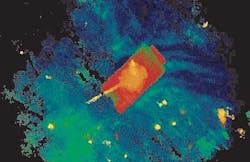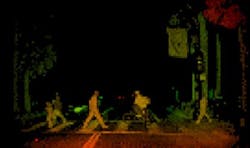DRS and Lockheed Martin join DARPA LRT program to develop new laser radar technologies
ARLINGTON, Va., 22 April 2013. Electro-optical sensor experts at Lockheed Martin Corp. and DRS Technologies Inc. are joining a U.S. military research program to develop laser detector array and laser transmitter technologies for multiple-modality, diverse-waveform laser radar (lidar) systems.
DRS RSTA Inc. in Dallas and Lockheed Martin Coherent Technologies Inc. in Louisville, Colo., are joining the Laser Radar Technology (LRT) program of the U.S. Defense Advanced Research Projects Agency (DARPA) in Arlington, Va.
DRS and Lockheed Martin Coherent join Princeton Lightwave Inc. in Cranbury, N.J., on the DARPA LRT program to develop lidar technologies for advanced military targeting, surveillance, and reconnaissance.
DRS won a $4.4 million DARPA LRT contract Friday; Lockheed Martin Coherent won a $3.2 million contract on Thursday, and Princeton Lightwave won a $3.1 million DARPA LRT contract on 3 April.
DRS engineers will develop a pixel linear detection mode avalanche photodiode array, that will be light sensitive. Lockheed Martin Coherent, meanwhile, will develop a dual-mode high-efficiency laser transmitter with waveform diversity for multi-mode active sensing in a single laser radar sensor.
Princeton Lightwave researchers will work on laser transmitter technology that generates variable-duration pulses that can support high-frequency modulation. DARPA officials want the company to work on laser transmitters and receivers that operate at a nominal eyesafe wavelength.
Ladar, also known as light detection and ranging (LIDAR), measures the distance to targets by illuminating the target with laser light and analyzing the backscattered light. Essentially lidar does with light what radar does with RF energy.
Scientists in the DARPA Strategic Technology Office have been working on the LRT program since September 2012 when the agency released the original solicitation.
The DARPA LRT program is focusing on two areas of lidar technology research: detector arrays and laser sources.
Laser detector array research seeks to support advanced lidar systems with sensors able to detect optical backscatter from different laser transmit waveforms. These detectors must operate not only in a direct-detection mode, but also in coherent detection mode.
Laser source research seeks to develop high-efficiency, high-power, laser sources able to support direct and coherent detection waveforms -- or generate high- and low-duty factor waveforms with frequency and phase modulation.
The military is interested in lidar for high-definition imaging systems that collect enough detail to identify targets, such as tanks, aircraft, or humans on foot.
Examples of military applications of lidar include the Airborne Laser Mine Detection System (ALMDS) for counter-mine warfare. Other military applications of lidar may involve detecting and discriminating biological warfare agents.
The military also is interested in lidar for unmanned vehicles navigation and guidance -- particularly for enabling unmanned aircraft and unmanned ground vehicles to avoid obstacles. Ladar as a target-detecting and -tracking system is considered to be more difficult to detect and jam for enemy forces.
For more information contact DRS RSTA online at www.drs.com/Products/RSTA, Lockheed Martin at www.lockheedmartin.com, Princeton Lightwave at www.princetonlightwave.com, or DARPA at www.darpa.mil.


